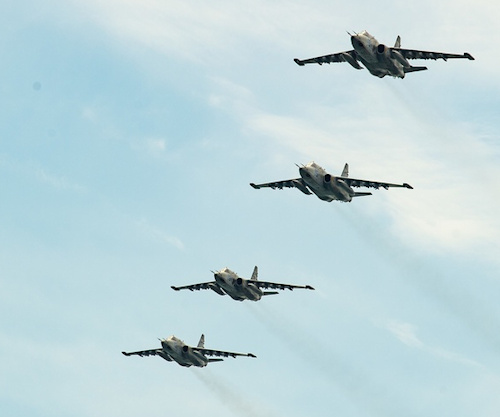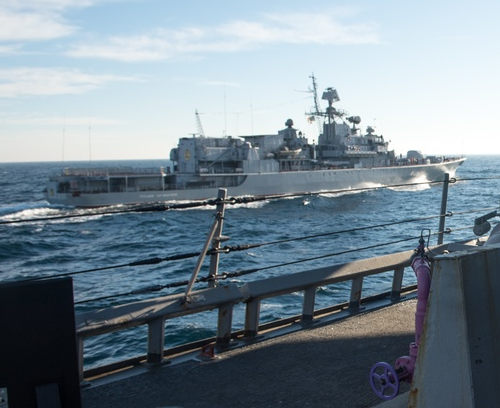The second component of the Ukrainian Armed Forces is the Air Force, already partially touched upon in the analysis entitled "Swarm of Fire".
Upon independence from the USSR, Ukraine inherited a huge air fleet consisting of at least 1.500 fixed-wing combat aircraft, not counting reconnaissance, transport and helicopters. Interestingly, Ukraine also possessed strategic aviation which grouped all the strategic bomber regiments inherited from the Red Empire.
The economic crisis, the international disarmament treaties and a general lack of interest on the part of politics have had the effect of causing the vertical drop in the operational capabilities of the Air Forces which had to radiate or sell off most of the assets.
In 2014 the Ukrainian Armed Forces were completely taken aback by the Russian annexation of Crimea and the outbreak of the conflict in Donbass, nevertheless the Air Forces were immediately thrown into the battle, sustaining heavy losses of men and vehicles. According to official estimates, between April and August 2014, Ukrainians suffered the loss of 22-23 airplanes and helicopters, after which they stopped publishing any news related to the losses suffered. According to a report by the Swiss defense holding RUAG, which specializes in the aeronautical sector, however, in the period between April 2014 and October 2015, the Ukrainian Air Forces lost 222 of the 400 aircraft available to them. beginning of hostilities, due to enemy action, “friendly fire” and flight accidents; an alarming rate of losses.
Today the Air Forces include the following components: theCombat Aviation, L 'Auxiliary Aviation, Antiaircraft Defense Missile Forces and Radar Forces.
The Combat Aviation gathers the departments equipped with high-performance jets which count 98 aircraft in total. Specifically, they are: 12 Sukhoi Su-24 tactical bombers, 17 Sukhoi Su-25 tactical support fighter-bombers, 37 Mikoyan-Gurevich Mig-29 multi-role fighters and 32 Sukhoi Su-27 piloted interceptors.

The Auxiliary Aviation controls the units assigned to air transport, equipped with 15 transport and Mil Mi-8 transport helicopters, 22 Antonov An-26 medium transport aircraft, 7 Ilyushin Il-76 heavy transport aircraft and the only one. of the revolutionary but unfortunate Antonov An-70 transport plane, while the Antonov An-178 has not yet entered service, even if ordered in 3 units. There is also a small reconnaissance component articulated on 3 Antonov An-30s while training is guaranteed by the availability of 47 Aero L-39 Albatross.
All aircraft in service, with the exception of the single Antonov An-70, have been inherited from the Soviet period and, with the exception of the Aero L-39 Albatross which are of Czechoslovakian origin, the other planes and helicopters are of Soviet production. Adding up all the numbers cited above, we see that the Ukrainian Air Forces have a total of 193 aircraft in service which, when compared to the numbers provided by the RUAG report, makes the Swiss claim about the losses suffered by the Ukrainians in the course credible. Of the war.
The other two components of the Air Forces, the Antiaircraft Defense Missile Forces and the Radar Forces are closely integrated and collaborate in the defense of military airports by aligning over 500 missile systems S-125 Neva / Pechora, 2K12 Kub, 9K37 Buk, 9K330 Tor, S -300PT and S-300PS in addition to the extensive surveillance radar system that assist them in identifying and engaging possible threats.
The fourth branch of the Ukrainian Armed Forces is the Navy and, as already mentioned in the past, it has suffered much more than the others from the financial and organizational collapse of the 350s and XNUMXs. At the time of the dissolution of the USSR, the newborn Russia and Ukraine reached an agreement to divide the Soviet Black Sea Fleet in half, and in this way Ukraine obtained a naval force that, in the combat branch alone, counted as many as XNUMX vessels!
The period between 1992 and 2014 was marked by a marked decline in service, with numerous naval units sold on international markets and the others simply left to "rot" in the ports of Sevastopol, Dunuzlav, Nikolayev and Odessa. Interestingly, the decay process of the blue weapon did not cease even after the events of 2014 as the Ukrainians continued to wipe out the few combat ships they had left to them "courtesy of the Russians" who returned them to them as " a sign of good neighborliness ”after the“ rape of Crimea ”.
 Today the Ukrainian Navy has a total of 71 naval units, but only one, the frigate Hetman Sahaidashny (photo) of the class Krivak III, can be considered a real warship (without missile armament!) while the others are patrol and support ships.
Today the Ukrainian Navy has a total of 71 naval units, but only one, the frigate Hetman Sahaidashny (photo) of the class Krivak III, can be considered a real warship (without missile armament!) while the others are patrol and support ships.
It is true that in the plans of the Ukrainian General Staff the Navy should over the next decade be strengthened by the entry into service of another 53 naval units among which 2 class frigates deserve to be mentioned Oliver hazard perry American-made, 4-class corvette Volodymyr Velikyi and 6 fast attack craft class Centaur of national production, 6 fast attack craft class barzan of British origin and 2 Adra-class corvettes of Turkish design but it is very unlikely that Russia will wait and do nothing, letting Ukraine strengthen itself in the Black Sea.
Given the importance that the domination of the seas has for all the great and small powers of the world, to truly believe that Russia is giving an openly enemy Ukraine the possibility of strengthening itself on the naval front frankly makes me smile.
In addition to surface ships, the Navy also controls three other separate corps: the Missile Artillery for Coastal Defense, Naval Aviation and the Navy Infantry.
The Missile Artillery for Coastal Defense has the task of defending the coasts of the country using both missiles inherited from the Soviet period and the brand new R-360 cruise missiles Neptun entered service in 2021.
Naval Aviation has 17 fixed-wing and rotary-wing aircraft and its mission is to support the operations of surface ships in guaranteeing Ukraine's sovereignty over its territorial waters.
The Navy Infantry aligns 5 brigades, 1 artillery regiment and several independent units and was heavily involved in the Donbass conflict in which all units took part in rotation.
The fourth branch of the Ukrainian Armed Forces consists of the Air Assault Forces, heirs of the Soviet-era VDVs. After various processes of reform and "streamlining", today the Air Assault Forces are divided into an airborne brigade (the 25a), five air assault brigades (45th, 46th, 79th, 80th and 95th), one aircraft (81st) and several independent units.
The Air Assault Forces are considered elite units of the Armed Forces and for this reason they have also been heavily involved in the Dobass conflict in the role of "assault infantry".
The last branch of the Ukrainian Armed Forces is constituted by the Special Operations Forces which, despite the attempt made in recent years to bring them closer to the so-called "West", from the point of view of the spirit and operational doctrines remain the heirs of the Soviet Spetsnaz. They number about 4.000 men and are organized into four regiments, three of which are assigned to "land" operations and the last to naval ones, and several other support units.
Special Operations Forces were also heavily deployed in the clashes in Donbass and were likely responsible for the targeted assassinations of some of the political and military leaders of the breakaway republics of Donetsk and Lugansk.
(Go on)
Ukraine to the test of fire: resistance or surrender? (first part)
Ukraine to the test of fire: resistance or surrender? (Part Three)
Photo: US Air National Guard / US Navy












